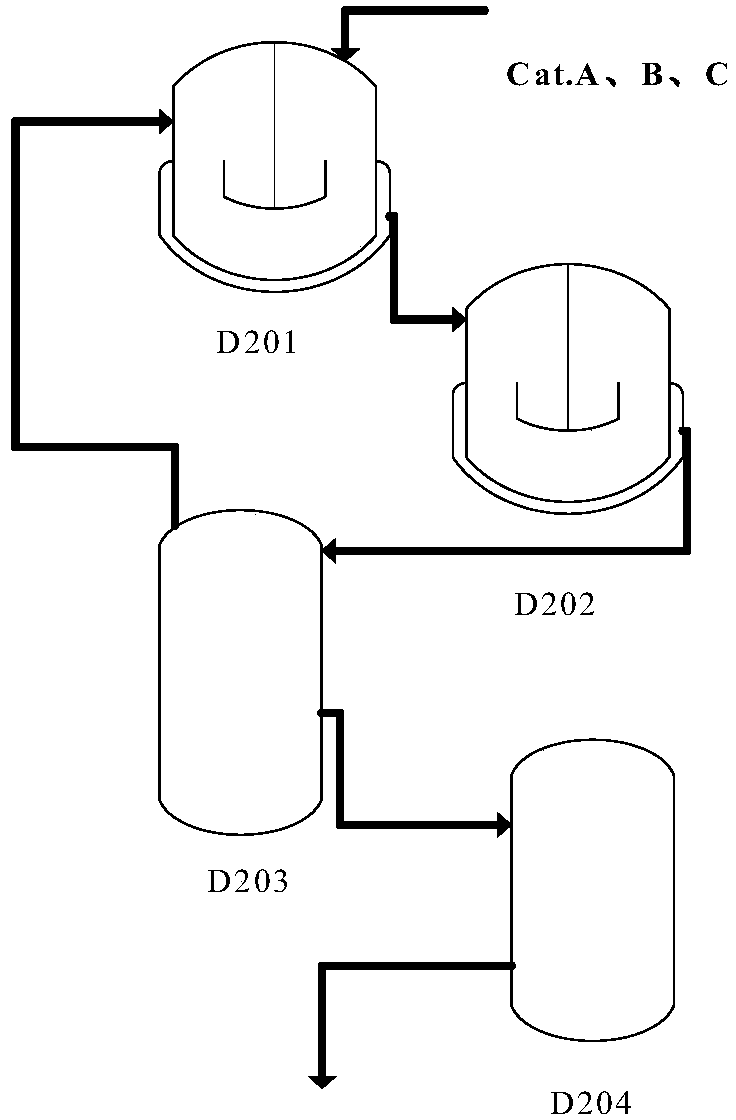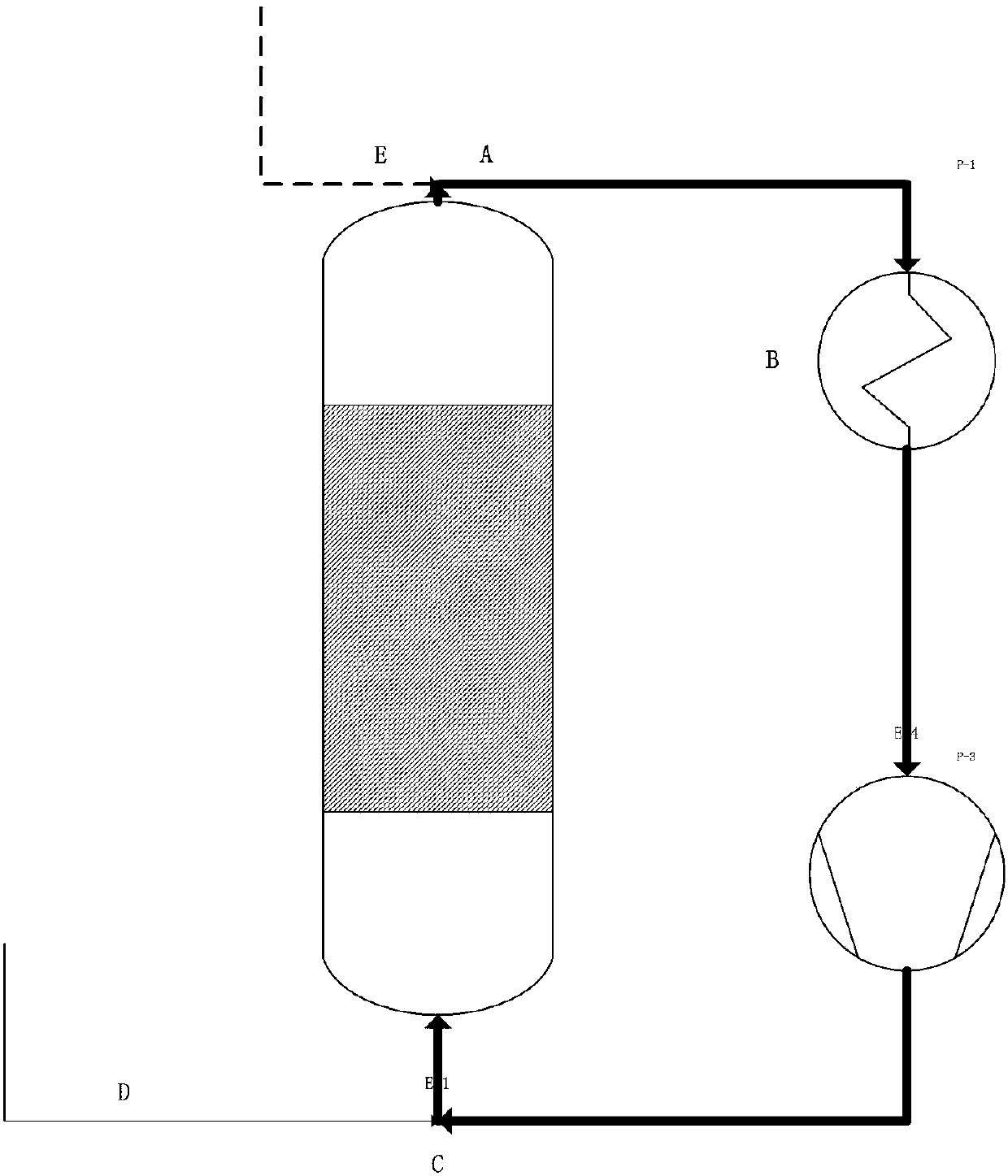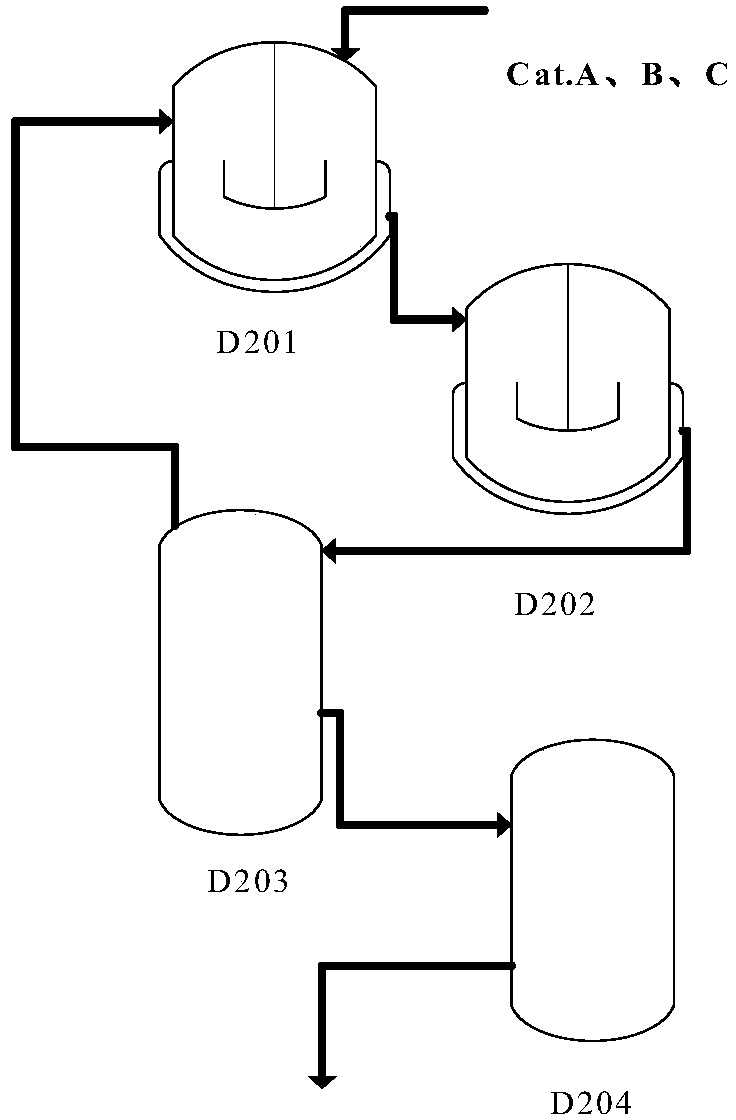Method for producing ethylene copolymerized polypropylene through propylene bulk gas phase combination technology
An ethylene copolymer polypropylene, production process technology, applied in the chemical industry, climate sustainability, sustainable manufacturing/processing, etc. The effect of maintaining long-term stable operation, simple and easy preparation process, and avoiding fluctuations in device operation
Inactive Publication Date: 2017-05-24
SINOPEC YANGZI PETROCHEM +1
View PDF1 Cites 2 Cited by
- Summary
- Abstract
- Description
- Claims
- Application Information
AI Technical Summary
Problems solved by technology
[0003] But existing gas-phase polymerizer must add tack-resisting agent LPN when producing copolymer, and LPN is a kind of nitrogen containing oxygen, is used for preventing polymer particle surface from generating the undesirable sticky copolymer, but adds a large amount At the same time, LPN also brings a series of problems, such as, the oxygen and molecular weight regulator hydrogen in a.LPN have a very wide explosion limit, and the electrostatic effect on the surface of the polymer has the potential danger of hydrogen and oxygen explosion. For safety reasons, As a result, hydrogen cannot be added to the device when producing copolymers, which limits product performance optimization and production of different grades of products; b. The addition of a large amount of LPN and the accumulation of a large amount of inert gas reduce the partial pressure of effective monomers participating in the polymerization, resulting in polymerization production efficiency Decrease, roughly estimated, when nitrogen is balanced, the partial pressure is about 50%, and compared with no nitrogen, the polymerization production efficiency will drop by at least 50%; c. Excessive nitrogen increases the discharge frequency of the gas phase kettle, increases the amount of post-treatment separation, and improves production Cost, if it is directly emptied, the unit consumption of the product will increase significantly
[0004] At the same time, due to the unavoidable existence of polymerized fine powder in the reactor, under normal circumstances, there are still a very small amount of ultrafine particles that pass through the filter separation device of the fluidized bed and enter the circulation pipeline. These ultrafine powders still have a high Active, easy to attach to the inner wall and grow, so that a layer of polymer gradually grows on the inner wall, resulting in a sharp drop in heat exchange efficiency, increased energy consumption and blocked pipes. The cycle of normal and stable production is short, requiring manual and material resources to stop and clean
[0005] In addition, because polypropylene is a poor conductor of electricity, the continuous friction of the polymer flowing in the gas phase kettle will generate a lot of static electricity. Due to the electrostatic effect, some polymer fine powder or particles will adhere to the reactor wall, and those attached to the The fine powder on the wall of the feeding pipe and the inner wall of the heat exchanger will engulf part of the ethylene-propylene rubber formed after copolymerization, resulting in poor conveyance of the polymer in the feeding pipe and a decrease in the heat transfer efficiency of the heat exchanger. With the prolongation of production time during polypropylene copolymerization, it becomes more and more difficult to remove the heat, and blockage of the feeding pipeline occurs from time to time, which affects the stable operation of the device and also causes fluctuations in product quality
Method used
the structure of the environmentally friendly knitted fabric provided by the present invention; figure 2 Flow chart of the yarn wrapping machine for environmentally friendly knitted fabrics and storage devices; image 3 Is the parameter map of the yarn covering machine
View moreImage
Smart Image Click on the blue labels to locate them in the text.
Smart ImageViewing Examples
Examples
Experimental program
Comparison scheme
Effect test
Embodiment Construction
[0033] In order to better understand the present invention, the content of the present invention will be further clarified below in conjunction with the embodiments, but the content of the present invention is not limited to the following embodiments.
the structure of the environmentally friendly knitted fabric provided by the present invention; figure 2 Flow chart of the yarn wrapping machine for environmentally friendly knitted fabrics and storage devices; image 3 Is the parameter map of the yarn covering machine
Login to View More PUM
 Login to View More
Login to View More Abstract
The invention discloses a method for producing ethylene copolymerized polypropylene through a propylene bulk gas phase combination technology. Propylene polymerizes under the action of a catalyst containing a transition metal active site to generate polypropylene, the obtained polypropylene and ethylene polymerize in a gas phase reactor, an adhesion inhibitor is added in the polypropylene and ethylene polymerization process, and the adhesion inhibitor is a mixture of alcohol and an antistatic agent. The method has the advantages of no explosion danger, high polymerization production efficiency, low energy consumption, elimination of polymer adhesion, reduction of the adhesion of fine polymer powder to the inner wall of the reactor, stable device running, effective elimination of the scaling phenomenon of the inner wall of the reactor, solving of the problem of low polymerization efficiency caused by existence of a large amount of inert gas in the polymerization reactor, and solving of the problems of unsmooth conveying of a polymer in a discharging tube and reduction of the heat exchange efficiency of a heat exchanger.
Description
Technical field [0001] The invention relates to a method for producing ethylene copolymer polypropylene on a propylene bulk gas phase combined production process, and belongs to the field of olefin polymerization in the petrochemical industry. Background technique [0002] The existing polyolefin production process for industrial production is mainly liquid phase bulk and gas phase, with a single form of multi-tank combination, or two forms of multi-tank combination. Although there are various forms for the gas phase polymerizer, its characteristic is that it is mainly composed of two parts: a flow reaction part and a circulating heat exchange part. The gas phase polymerizer can avoid the formation of a small amount of low molecular weight copolymers dissolved in propylene during liquid phase bulk polymerization when producing propylene and α-olefin polymers. [0003] However, the existing gas-phase polymerizer must add the adhesion inhibitor LPN when producing the copolymer. LPN ...
Claims
the structure of the environmentally friendly knitted fabric provided by the present invention; figure 2 Flow chart of the yarn wrapping machine for environmentally friendly knitted fabrics and storage devices; image 3 Is the parameter map of the yarn covering machine
Login to View More Application Information
Patent Timeline
 Login to View More
Login to View More IPC IPC(8): C08F255/02C08F210/02C08F2/02C08F2/34C08F2/38
CPCY02P20/10
Inventor 李栋王兴仁
Owner SINOPEC YANGZI PETROCHEM
Features
- R&D
- Intellectual Property
- Life Sciences
- Materials
- Tech Scout
Why Patsnap Eureka
- Unparalleled Data Quality
- Higher Quality Content
- 60% Fewer Hallucinations
Social media
Patsnap Eureka Blog
Learn More Browse by: Latest US Patents, China's latest patents, Technical Efficacy Thesaurus, Application Domain, Technology Topic, Popular Technical Reports.
© 2025 PatSnap. All rights reserved.Legal|Privacy policy|Modern Slavery Act Transparency Statement|Sitemap|About US| Contact US: help@patsnap.com



